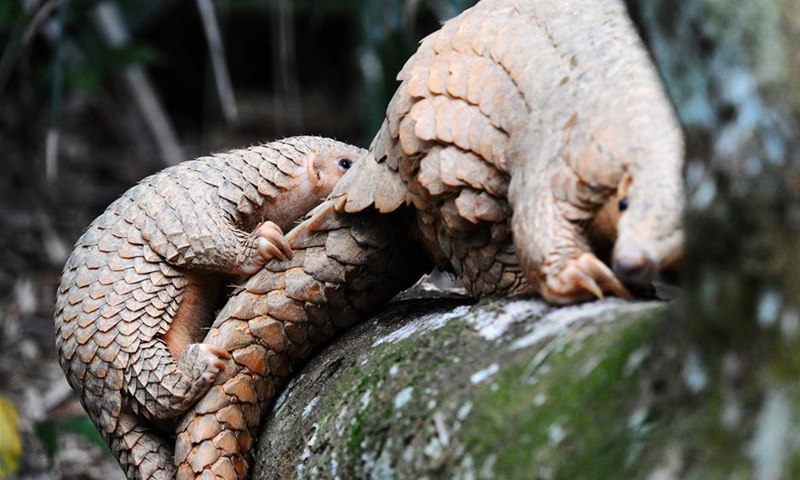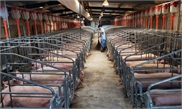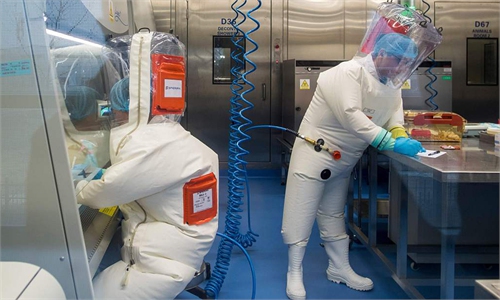Latest report of China's bat woman shows novel coronavirus closer to pangolins, ‘unlikely from Wuhan lab’

File photo of a baby Sunda pangolin and its mother Photo: Xinhua
Latest research again indicates that it was unlikely the novel coronavirus was leaked from the Wuhan Institute of Virology (WIV), experts said, amid US media's recent hyping of the lab leak theory ahead of the World Health Assembly (WHA).
Researchers from the WIV and the University of Chinese Academy of Sciences, including Shi Zhengli, who has been dubbed China's "Bat Woman" for her years of research and achievements with bats and viruses, published a report on Friday on BioRxiv that further refutes the hyped theory that the virus came from the laboratory.
The research shows that none of the known viruses of the bat SARSr-CoV-2 lineage or its novel variant use the human ACE2 as efficiently as SARSr-CoV-2 from pangolins or some of the SARSr-CoV-1 lineage viruses.
"These results suggested the SARSr-CoVs discovered in bats now may be just the tip of the iceberg. These viruses may have experienced selection or recombination events in the animal hosts and rendered viral adaption to a new host and then spread to the new species before they jumped to humans," researchers said in the report.
Bats and pangolins are recognized as the most probable reservoir hosts that harbor viruses which are very similar to SARS-CoV-2.
Based on the Friday report, it is safe to say that bats are probable ancestors of the coronavirus that led to SARS in 2003 and the recent COVID-19 pandemic, and coronavirus strains discovered in pangolins are closer to the novel coronavirus in humans, Yang Zhanqiu, a virologist from the Wuhan University, told the Global Times on Tuesday, noting that the report still did not explain how the virus was transferred and adapted from bats to humans via pangolins.
But the results were enough to demonstrate that it is unlikely that the coronavirus leading to the deadly COVID-19 pandemic was leaked from the WIV, where Shi and her team kept virus samples from bats, a Beijing-based immunology expert told the Global Times on Tuesday on condition of anonymity.
"When we say a virus is from a lab, we are indicating that either the virus, or a highly similar virus, is leaked from a lab, or a virus is manufactured by man in a lab. But the two possibilities have both been refuted so far by scientific research," Zhuang Shilihe, a Guangzhou-based expert, told the Global Times on Tuesday.
The most likely process is that the coronavirus from bats had mutated in nature for decades before it successfully infected humans and led to the deadly COVID-19 pandemic, Zhuang said.
US politicians and media outlets have been pursuing the lab leak theory as the origin of COVID-19, despite scientists from the WHO-China joint study team concluding, in a full report after their field study in Wuhan, that a lab leak is extremely unlikely.
Hours before the WHA began on Monday, the Wall Street Journal ran a story, citing an undisclosed US intelligence report, indicating that three researchers from the WIV became sick in November 2019 with symptoms consistent with both COVID-19 and common seasonal illnesses.
Yuan Zhiming, director of the Wuhan National Biosafety Laboratory of the WIV, refuted the report, calling the story "an outright lie that came from nowhere."
The Global Times found that the claims of three WIV researchers getting sick had been spread by Australian media as early as March by Australian journalist Sharri Markson, an active disseminator of conspiracy theories and lies that smear China.
In early May, Markson released a so-called exclusive report in The Australian newspaper quoting a Chinese book that is openly on sale as a "leaked" exclusive document smearing China over the origins of COVID-19, twisting the book's contents to support her own conspiracy theory that China was engaged in weaponizing the novel coronavirus several years before the pandemic.
In May 2020, Markson revealed that a Five Eyes intelligence report claimed the novel coronavirus may have come from the Wuhan Institute of Virology. However, another Australian media outlet, The Age, soon pointed out that the so-called exclusive report was suspected of being provided by the US Embassy in Australia.
Chinese experts had reiterated that tracing the origins of the coronavirus is a scientific task and the aim of the work is to prevent future disasters rather than to assign responsibility.
Many international scientists have shown support for their Chinese counterparts over the issue, but recently some have left Chinese scientists feeling "betrayed" as they seem to be changing their tone.
The US' top epidemiologist Anthony Fauci said at a Poynter event earlier this month that he was not convinced the virus developed naturally, saying we should continue to investigate what went on in China, the New York Post reported on Sunday. However, last May, the US scientist said in an article in the National Geographic that there was "no scientific evidence the coronavirus was made in a Chinese lab."
Fauci's modification of his remarks sparked more speculation about the Biden administration's future moves of politicizing the virus origins.


